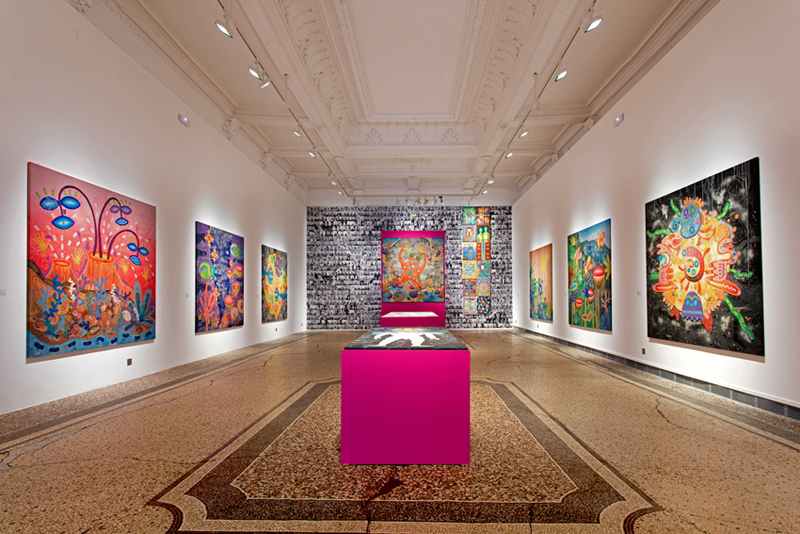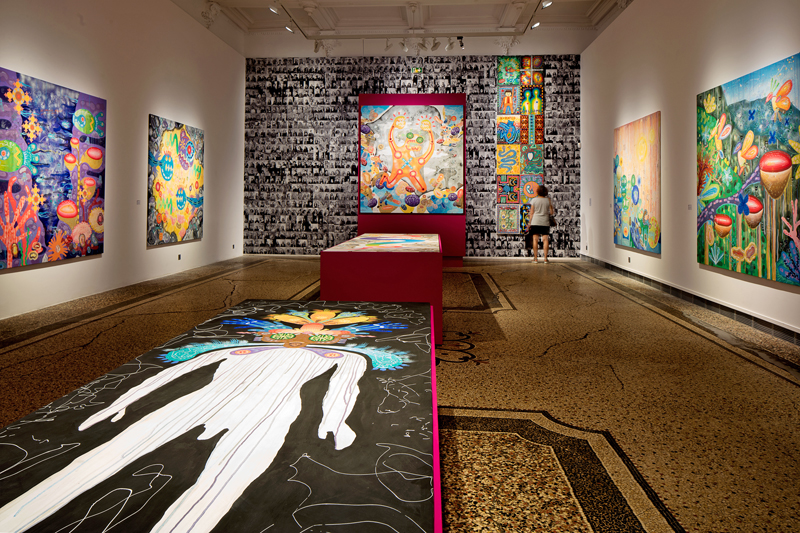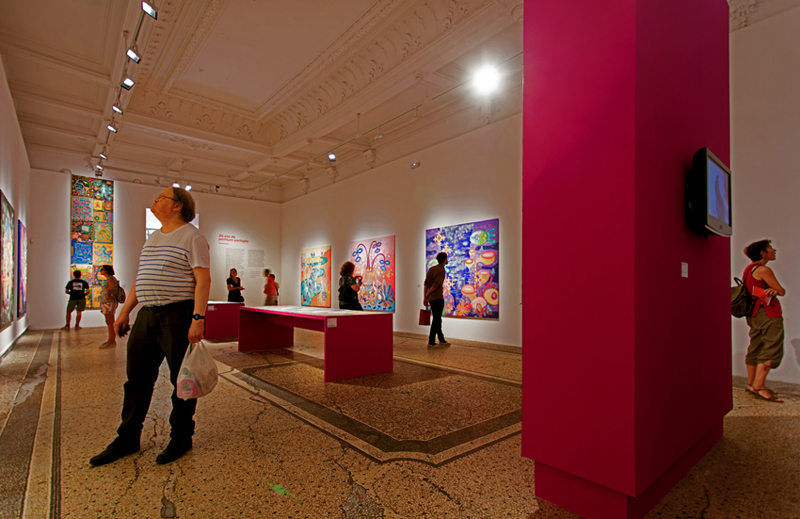With real pieces of people inside
Work: .
With real pieces of people inside. Graffitized paintings on canvas, size 200 x 200 cm.
Location:
Montpellier, France. 2017/2018.
Statement :
In 1998, drawing his inspiration from the practice of graffiti as much as from a particular idea of art called relational aesthetics, Yann Dumoget had the idea of asking those around him to write or draw on their own paintings with small felt-tip pens. indelible. Soon after, while he painted a canvas a day for a year, visitors followed one another in his studio to graffiti this set of 366 works and take part in what was his first major solo exhibition, in the year 2000, at the Carré Sainte-Anne in Montpellier.
Exactly 20 years later, after a number of artistic as well as geographical wanderings, the artist wanted to return to this initial practice for the Espace Dominique Bagouet, which he still considers to be an important pillar of his work.
Compared to some works from his beginnings, the exhibition will include around ten recent paintings that the artist offered for public contributions during events previously held in the city.
By giving several hundred Montpellier residents from different neighborhoods the opportunity to symbolically invest the exhibition space with him, Yann Dumoget offers a unique portrait of the city through the spontaneous expression of its inhabitants.
Reference text:
I have always liked Marcel Duchamp’s famous aphorism: “It is the viewers who make the paintings”. I see it as a powerful way of stating that no artistic act can be thought of independently of its context of reception. And claiming to be a painter at the start of the 21st century ultimately boils down to agreeing with one’s contemporaries on an idea of art and artists. In my case, the expression is even to be taken in the literal sense, because I tried from the beginning to translate this discussion into forms, to use my paintings as much to initiate an experience of meeting as to then keep the traces of these moments of exchange and sharing. From 1998, I used what seemed to me the simplest, most direct way to introduce heterogeneity into my productions: graffiti. Because I suspected that something interesting could be at play in the confrontation between the particular territory of my paintings and this universally widespread practice which for me referred to tagging, to this symbolic occupation of public space in which a growing number were engaged. of people. Because more than the expression of a wild individualism pushing the masses towards compulsive narcissism, I saw in it the confirmation that no one now had the feeling of existing in the social field without the possibility of taking part in it. spectacular way. All that remained over the years was to understand – that is to say not only to take with me, but to try to make intelligible – what was there to see. Twenty years ago , the digital revolution and the development of the Internet had a kind of fascination on me. I was full of enthusiasm in the face of this desirable future, in the face of this universalist cyberculture in which outdated hierarchies had to give way to a model of horizontal and reticular exchange promoting contribution and co-construction. My first paintings naively echoed it, like those presented in the introduction to this exhibition. Today, I see that the cracks of a world in full doubt also resonate in the most recent ones, too often giving way to fear and withdrawal. My concerns as an artist then join those of the citizen, attempting to construct his work as much as he himself by negotiating as best he can with his contradictory impulses of hospitality and hostility, between a desire for otherness and the fear of the alteration. Despite everything, I continue to dream of a reasoned sharing of the common. I continue to produce a few square meters of colorful utopia day after day, keeping in mind that at a time when totalitarianism seems more and more attractive to some, democracy is nothing other than a fragile attempt to invent spaces allowing everyone to give voice. So, on my tiny scale, I do my part. But leaving the government of brushes, what can the artist in the Anthropocene era, faced with the consumption of the world, faced with the feared disappearance of everything, starting with the inevitable disappearance of himself? Nothing or almost nothing, of course. This is why, in a ridiculous pirouette, I pretended in this exhibition to take myself for a shaman, for this being whose magic allows him to intercede with the spirits of time and nature. And if my paintings are like so many stations charged with your presence as animist statues could be, suffice to say that they are also screens which unfortunately hide the emptiness of my power. The artist is naked, art is ultimately only what we put there, only what we want to see there. Nothing more, but nothing less. Wishing you a good visit to this exhibition, I invite you to remember only one thing: one day, we were here, together. Like a memory that we could evoke again in a very long time. One day, we were here, together. And it was beautiful…
Shared painting :
For Yann Dumoget, shared painting is a pretext for meetings which are then formalized on the surface of the canvas until they represent a symbolic common space where the echoes of a changing world arrive. Transposition of our societies driven by the digital revolution towards a contributory and horizontal model, the collection of heterogeneous elements which elsewhere could relate to alteration asserts itself here on the contrary as a stimulating consideration of otherness. Motivated by a desire for “understanding” – in the etymological sense of taking with oneself – this refers to the antagonistic notions of hospitality and hostility from which the human and cultural flows generated by globalization can be thought of today. Here, Yann Dumoget is betting on believing in the co-construction of a plural and peaceful artistic identity, a pictorial version of a utopia that he wishes to be achievable. That, at a time when certain founding ideals seem to be losing their appeal, of a territory shared in good understanding as the basis of any democratic project.



